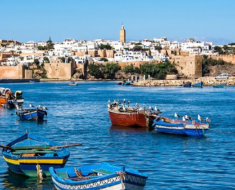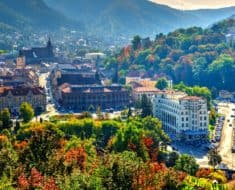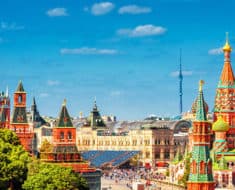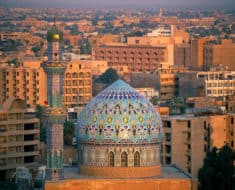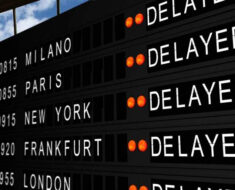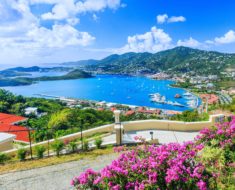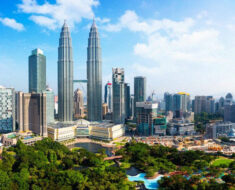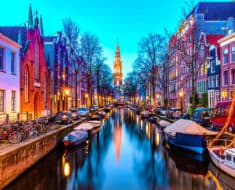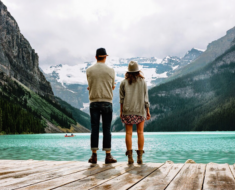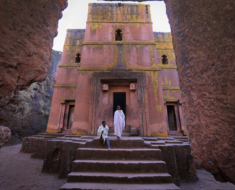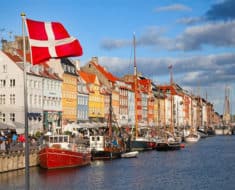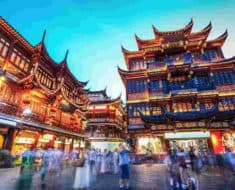
There is much more to see in Israel than religious and historic sites. So if you want to see more than the usual top 10 sites in Israel, then check out some of these quirky Holy Land attractions.
1. Pool of Arches, Ramla
Israel’s most ancient reservoir is hidden underground, in fact under a building. It is 1200 years old and accessed via a narrow flight of stone steps that leads down to the water. The arched roof is held up by 15 columns. In the ceiling, you can see an opening where people would have dropped their buckets down on a rope to collect water. Today, there are row boats in the underground reservoir so you can take a short row around the columns. While you are in Ramla there are a few other interesting attractions like the White Tower, Ramla Museum, and the Ramla Bazaar.
2. Elvis Diner
If you’re driving between Tel Aviv and Jerusalem and you need to stop for a bite to eat, why not pull into the Elvis Diner? The restaurant is located at a gas station in Neve Ilan and has been around for over 30 years. Of course, it was started by a hard-core Elvis fan, and it still attracts rock n’ roll aficionados. Get a selfie with the life-size Elvis statue, and see the collection of Elvis memorabilia displayed in the diner.
3. Museum on the Seam
This museum is located on the seam between East and West Jerusalem. It was founded in 1999 and is housed in a neo-classical former residential building. The museum focuses on the socio-political issues in contemporary Israel and Palestine. It has been named by the New York Times as one of the world’s top cultural sites to see before you die. The exhibitions include photography and art that sheds light on local issues such as freedom to protest, women’s rights, and environmental issues. If you’re taking one of the private Jerusalem tours with a guide you could include this museum in your itinerary.
4. Beit Jimal
One of the most out-of-the-way unique attractions in Israel, that is worth getting to, is the monastery at Beit Jimal. It is on the outskirts of Jerusalem, perched on a hill surrounded by forests. This picturesque monastery was established in 1892 and is home to Salesian monks. The monastery grounds are beautiful but the star attraction is the church where every inch of the walls and ceiling are covered with brilliantly painted murals. Be sure to pick up some of the olive oil and honey produced by the monks.
5. Curious Graves
In Israel, you’ll find several unusual gravestones. Firstly, there is the grave of Ida Kleinman in the Rehovot Cemetery. Dear old Ida was famed for her delicious nut roll cake. Her family loved it so much that they had the recipe engraved on her gravestone. Next, you can see the grave of Harry Potter, in the Ramla British Military Cemetery. The British soldier, Private Potter was killed while serving in Palestine in 1939. He was a driver in his battalion and had the nickname Crash Harry. Potter had lied about his age and joined the army when he was just 17 years old. Little did he know how famous his name would be more than five decades later. Finally, there is William Shakespeare, buried in the British Cemetery in Jerusalem. He was a 41-year-old driver in the British Royal Army Service Corps and was killed in 1918, during the war against the Ottomans.
6. Rappelling at the Ramon Crater
Take part in one of the extreme activities in the Negev, like exploring the Ramon Crater or even rappelling (abseiling) down the edge of this breathtaking natural wonder. Start in the town of Mitzpe Ramon, and together with your guide, decide whether you’re up for the 30-meter drop. If you are a beginner, you can opt for the 15-meter drop. After your descent, you can follow the walking path up to the top of the crater. You’ll get stunning views of the crater which is 40km long, between 2-10 kilometers wide, and about 500 meters deep.
7. Mifletzet
If you’re traveling with kids, you have to stop by the Mifletzet (monster), a playground super slide in one of Jerusalem’s residential neighborhoods. The avant-garde creature was created to help kids confront their fears in a safe environment and was originally called “The Golem.” The black and white creature has red slides coming out of its “mouth” like a giant tongue.
8. Kfar Kama Circassian Community
Don’t miss the opportunity to get to know one of Israel’s minority cultures. The Circassians are a Sunni Muslim sect who have unique food, traditional clothing, dance, and language. The Galilee village dates back to the 4th century and although it has changed names several times, its current recreation was established in the late 1800s. The Circassians fled persecution in the Russian Caucasus, and today there are about 2,900 Circassian residents in the village. The village welcomes tour groups, and visitors interested in learning about their culture.
9. Ashalim Tower
Like some sci-fi structure rising from the surface of a barren planet, the Ashalim Power Station towers over the Negev Desert. Not far from Beér Sheva, the tower stands out on the flat horizon. But the first thing you’ll see is the light shining from the top of the tower. The tower was built in 2019 and is the tallest solar power station in the world. It stands 260 meters tall and is surrounded by 56,000 solar panels that reflect sunlight onto the tower. The solar panels (heliostats) are computer operated and move to follow the sun from east to west through the day. You can see this futuristic site about 4 km south of the Tlalim Junction on Route 211.
10. Negev Weaving and Embroidery
You can get to know the Bedouin culture in Israel and pick up some unique souvenirs at the Negev Desert Weaving and Embroidery Center. Here local Bedouin women show visitors how they create their traditional clothing and textiles. Their craft center is near the settlement of Lakiya near Beér Sheva, and you can watch them working, see a display of their crafts, and buy some of their creations. You’ll see handmade purses, clothing, wall hangings, rugs, and more. There are carpets and larger textile items made from spun camel, goat, and sheep hair. There are also workshops for anyone who wants to try their hand at the local crafts.








